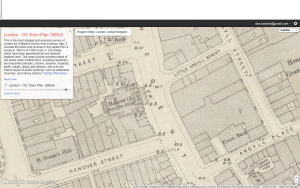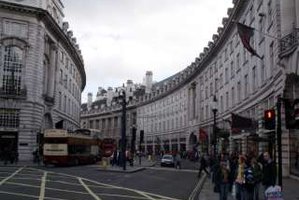“Then he turned up into Regent Street and made a cross cut through the slums that lie on the borders of Soho” (Sharp, 186).
So reads the only mention of Regent Street in the short story “In Dull Brown” by Evelyn Sharp. After finishing the story and realizing that the street was only mentioned once, I didn’t have very high expectations about where it might be located in London. But after consulting the Historical Eye site as well as the British History Online I learned that it was in fact quite a nice area to be in. It was considered “as one of the great show-places of fashionable London” (Historical Eye). After reading more about it and looking at it on a map, it became very clear to me why it was only mentioned once in the text. Regent Street is a long street that runs down in between two different parts of London. It’s a connecting street, and at the time it was a fairly new concept as a part of the city. Designed by John Nash in the early 1800s, Regent Street was one of the first attempts to make London more continuous and have more of a focus on long-lasting architectural style. As Edward Walford wrote in 1878 in Old and New London, “It belongs to “new,” and not to “old” London” (British History). In the story, Tom is described as turning “up into Regent Street” and crossing “through the slums that lie on the borders of SoHo” (Sharp.) He passes through Regent Street for a moment, only needing it to connect to Oxford Street to run into Jean. It is a pleasant detour, a street at the time that people had grown accustomed to enough that they didn’t necessarily need to stop and admire it, or mention it more than once in a short story. Especially if the characters in question are rather well off and used to walking through pleasant streets with people similar to them, it would not have been anything novel.
With this idea of “new” in mind, another connection I made is the newness to Regent Street and how Jean was a “new woman” at the time. Jean is an unconventional female protagonist for the time; she’s intelligent, she works for a living, and she is unmarried. She goes against everything that society deemed desirable during this era. The way she talks to Tom is very blunt and unapologetic which was also a very new idea, the idea that women could be equal to men in intellect. The frank conversations Tom has with Jean make him almost uncomfortable and it is noted in the text that Tom prefers “domesticated women,” which Jean is certainly not. He is intrigued by Jean but not necessarily capable of loving her and the end of the story shows him fawning over Jean’s sister Nancy, who much better fits the idea of womanhood at the time.
Regent Street is a small part of “In Dull Brown” but it does connect to the story in a very noted way. It shows the transition London was in the middle of making from old to new, from medieval to modern. Jean also represents this transition from old to new but Sharp is careful to point out that despite the city’s improvements, women were still largely stuck with medieval concepts of what it meant to be a woman. Today, Regent Street is a kind of equivalent to Time’s Square in New York and is “home to branches of the most famous and most expensive shops in the world” (Historical Eye). For what is now an attraction for mostly tourists, it’s interesting to think about its place in Victorian London and what it represented for its citizens.
Edward Walford, ‘Regent Street and Piccadilly’, in Old and New London: Volume 4 (London, 1878), pp. 246-262 http://www.british-history.ac.uk/old-new-london/vol4/pp246-262 [accessed 10 September 2015].
Sharp, Evelyn. “In Dull Brown.” The Yellow Book 8 (January 1896): 181-200. The Yellow Nineties Online. Ed. Dennis Denisoff and Lorraine Janzen Kooistra. Ryerson University, 2012. Web.
“The Historical Eye.” Web. September 10, 2015.




Wow, very fascinating history of London. Thank you for sharing, looking forward for your latest post 🙂 http://telkomuniversity.ac.id